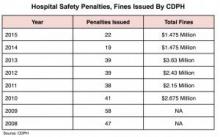Steep Drop In Hospital Safety Citations

The California Department of Public Health has pulled back on issuing citations and fines to the state's acute care hospitals for medical errors or other incidents that endanger the lives of patients, records show.
The agency was granted the authority in 2007 to fine hospitals as much as $50,000 per incident where it determined that a patient's life was in danger. Subsequent legislation increased the maximum fine to $100,000.
An analysis by Payers & Providers has concluded that while CDPH aggressively began issuing citations and fines in the first few years after it was authorized to do so, it has cited significantly fewer hospitals in recent years.
In 2015, CDPH cited 22 hospitals and levied $1.475 million in fines, records show. It cited 19 hospitals and also issued $1.475 million in fines in 2014.
But that is far less than in 2013, when it cited 39 hospitals and issued $3.63 million in fines, the highest dollar total to date, according to records. But the number of hospitals cited is far less than the agency's high water mark of 2009, when it cited 58 facilities in total.
On a regional basis, the comparison is often stark. In Los Angeles County, whose nearly 11 million inhabitants represent nearly one-third of the state's population, the CDPH issued two citations last year and five in 2014. In 2009, it issued 12.
The last publicly announced citations and fines were announced in May 2015, nearly eight months ago – the longest period between disclosures of penalties and fines. More recent announcements of fines have been quietly posted on the agency's website without holding a press conference, which had been commonplace up until 2014.
Few patient safety groups were willing to comment on the record about the drop-off, but it raised concerns for one of the most prominent, San Francisco-based Consumers Union.
“I would say it is disappointing that their (assessed penalties and fines) are going down. I don't suspect that is a reflection of hospitals being more than twice as safe today than back in 2008,” said Lisa McGiffert, director of that organization's Safe Patient Project.
McGiffert praised California for permitting regulators to fine hospitals, noting it is one of only a handful of states that does so. She added that the legislation mandating the penalties and fines is a model for the rest of the country to emulate.
However, the state's hospital sector has been less sanguine about the law. The California Hospital Association objected to the initial legislation until lawmakers agreed to lower the fines that were issued.
CDPH officials did not immediately respond to questions submitted by Payers & Providers, including the reasons for the drop-offs.
CDPH has been beleaguered in recent years. The agency has been the subject of several recent scathing audits by the California Auditor. In a 2014 report, Auditor Elaine Howle blasted CDPH for having more than 10,000 open cases regarding safety issues at long-term healthcare facilities. “Public Health has not established formal policies and procedures for ensuring prompt completion of investigations of complaints related to facilities or to the individuals it certifies,” the report concluded. A 2011 report also chided CDPH for incorrectly lowering penalties levied against providers because payments were made outside of a statutory timeframe when such reductions could be made.
On the hospital end, many acute care facilities have been able to successfully challenge penalties and fines in state administrative law court, arguing that CDPH exceeded the time permitted under statute to take action, a legal concept known as laches. Both the CDPH and the attorneys representing the hospitals in these actions have been reluctant to discuss those cases in the past.
“They are ridiculously slow to react and get things done,” said the former CEO of a prominent Los Angeles-area hospital about CDPH inspectors and managers. He asked not to be identified.
McGiffert believes that the successful appeals may be chastening the CDPH from being more aggressive in its enforcement work.
“It could be an adjustment by the agency in response to the appeals that they have had, and that is unfortunate. I think sometimes those kinds of reactions can lead to less oversight than is needed.”
Both that CEO and Betsy Imholz, a special projects director at Consumers Union, have noted that departures from the agency of top officials in charge of safety initiatives and hospital inspections in recent years may also be hampering CDPH's ability to inspect hospitals and take action.






